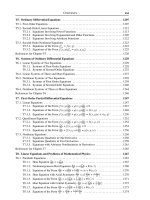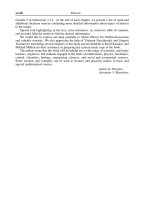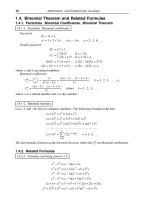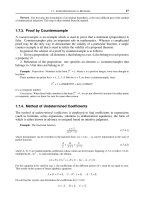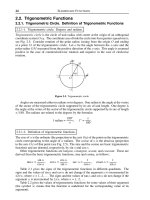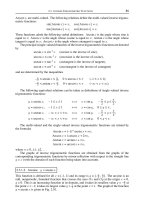Handbook of mathematics for engineers and scienteists part 66 ppsx
Bạn đang xem bản rút gọn của tài liệu. Xem và tải ngay bản đầy đủ của tài liệu tại đây (411.73 KB, 7 trang )
10.2. MAIN APPLICATIONS 423
Let us present some formulas that allow one to find the images of straight lines and
circles for an arbitrary linear-fractional mapping (10.2.1.2).
1. The straight lines Re(λz)=α that do not pass through the point z =–d/c (α ≠
–Re(λd/c)) are taken to the circles |w – w
0
| = ρ,where
w
0
=
2aα¯c + a
¯
d
¯
λ + b¯cλ
2α|c|
2
+ 2 Re(c
¯
d
¯
λ)
, ρ =
a
c
– w
0
.
2. The straight lines Re(λz)=–Re(λd/c) passing through the point z =–d/c are taken
to the straight lines
Re
ad – bc
c
2
λ ¯w
=Re
ad – bc
c
2
λ¯a
¯c
.
3. The circles |z – z
0
| = r that do not pass through the point z =–d/c (r ≠ |z
0
+ d/c|)are
taken to the circles |w – w
0
| = ρ,where
w
0
=
(az
0
+ b)(¯c¯z
0
+
¯
d)–a¯cr
2
|cz
0
+ d|
2
– |c|
2
r
2
, ρ =
r|ad – bc|
|cz
0
+ d|
2
– |c|
2
r
2
.
4. The circles |z – z
0
| = |z
0
+ d/c| are taken to the straight lines
Re
ad – bc
c(cz
0
+ d)
¯w
=
|ad – bc|
2
+ 2 Re[c(az
0
+ b)(ad – bc)]
2|c(cz
0
+ d)|
2
.
If a linear-fractional mapping takes four points z
1
, z
2
, z
3
,andz to points w
1
, w
2
, w
3
,
and w, respectively, then the following relation holds:
w – w
1
w – w
3
w
2
– w
3
w
2
– w
1
=
z – z
1
z – z
3
z
2
– z
3
z
2
– z
1
.(10.2.1.3)
T
HEOREM.
There exists a unique linear-fractional mapping of the extended
z
-plane onto
the extended
w
-plane taking three arbitrary distinct points
z
1
,
z
2
,and
z
3
to three arbitrary
distinct points
w
1
,
w
2
,and
w
3
, respectively.
THEOREM.
Any disk of the extended
z
-plane can be transformed into any disk of the
extended
w
-plane by a linear-fractional function.
Example 6. A mapping of the upper half-plane onto the unit disk.
Let a be the point of the upper half-plane which should be taken to the center w = 0 of the disk (Fig. 10.14).
Then the problem is solved by the linear-fractional function
w = e
iβ
z – a
z – ¯a
,
where β is an arbitrary real number. (Changing α means rotating the disk around the center w = 0.)
X
a
Y
U
O
V
Figure 10.14. A mapping of the upper half-plane onto the unit disk.
424 FUNCTIONS OF COMPLEX VARIABLE
Example 7. A mapping of the unit disk onto the upper half-plane.
Let a = ih be the point of the upper half-plane to which the center z = 0 of the disk should be taken
(Fig. 10.15). Then the problem is solved by the linear-fractional function
w = ih
e
iβ
+ z
e
iβ
– z
,
where β is an arbitrary real number. (Changing β means rotating the disk around the center w = 0.)
U
ih
V
X
O
Y
Figure 10.15. A mapping of the unit disk onto the upper half-plane.
Example 8. A mapping of the unit disk onto the unit disk.
Let a be the point of the disk |z| < 1 that should be taken to the center of the disk |w| < 1 (Fig. 10.16). Then
the problem is solved by the linear-fractional function
w = e
iβ
z – a
1 – z¯a
,(10.2.1.4)
where β is an arbitrary real number.
XX
a
O
YY
Figure 10.16. A mapping of the unit disk onto the unit disk.
Geometrically, β is the angle of rotation of the mapping (10.2.1.4) at the point a:
β =arg
dw
dz
.
If the radius of the disk in the z-plane is equal to R, then the function w = f(z) mapping this disk onto the disk
|w| < 1 and satisfying f(a)=0 and arg f
z
(a)=β has the form
w = e
iβ
R(z – a)
R
2
– z¯a
.
10.2.1-4. Mappings determined by the Zhukovskii function.
The mapping (see also Paragraph 10.1.2-3)
w =
1
2
z +
1
z
(10.2.1.5)
is conformal except at the points z =
1.
10.2. MAIN APPLICATIONS 425
The mapping given by the Zhukovskii function is equivalent to the following mappings:
z = w +
√
w
2
– 1 or
w – 1
w + 1
=
z – 1
z + 1
2
.(10.2.1.6)
If we denote z = re
iϕ
and w = u + iv, then the mapping (10.2.1.5) can be written as
u =
1
2
r +
1
r
cos ϕ, v =
1
2
r –
1
r
sin ϕ.(10.2.1.7)
The main properties of the mapping (10.2.1.5) are given in Table 10.2.
TABLE 10.2
Properties of mapping w =
1
2
z +
1
z
,wherez = x + iy = re
iϕ
, w = u + iv = ρe
iθ
No.
z-plane w-plane
Remarks
1
Circle
|z| = r
0
< 1
Ellipse
u
2
a
2
+
v
2
b
2
= 1,
where a =
1
2
(1/r
0
+ r
0
),
b =
1
2
(1/r
0
– r
0
)
The ellipse has the negative sense.
The foci are at the points
1.
2
Circle
|z| = r
0
> 1
Ellipse
u
2
a
2
+
v
2
b
2
= 1,
where a =
1
2
(1/r
0
+ r
0
),
b =
1
2
(1/r
0
– r
0
)
The ellipse has the positive sense.
The foci are at the points
1.
3
Radii
arg z = ϕ
0
(0 < r < 1)
Hyperbolas
u
2
cos
2
ϕ
0
–
v
2
sin
2
ϕ
0
= 1
The foci are at the points 1.
4
Semicircle
|z| = 1,Imz ≥ 0
Segment
| Re w| ≤ 1,Imw = 0
u decreases with increasing ϕ.
5
Semicircle
|z| = 1,Imz ≤ 0
Segment
| Re w| ≤ 1,Imw = 0
u increases with increasing ϕ.
6
Segment
0 <Rez < 1,Imz = 0
Half-line
Re w > 1,Imw = 0
—
7
Segment
–1 <Rez < 0,Imz = 0
Half-line
Re w <–1,Imw = 0
—
8
Half-line
Re z > 1,Imz = 0
Half-line
Re w > 1,Imw = 0
—
9
Half-line
Re z <–1,Imz = 0
Half-line
Re w <–1,Imw = 0
—
Example 9. The Zhukovskii function defines the following conformal maps:
1. It maps the interior of the semicircle |z| < 1,Imz > 0, onto the lower half-plane (Fig. 10.17). The point
z = 1 is taken to the point w = 1, and the point z = i is taken to the point w = 0.
2. It maps the upper half-plane with the disk |z| < 1 deleted onto the upper half-plane (Fig. 10.18).
3. It maps the half-annulus 1 < |z| < k,Imz > 0, onto the half-ellipse given by the equation
2ku
k
2
+ 1
2
+
2kv
k
2
– 1
2
= 1
on the w-plane (Fig. 10.19).
426 FUNCTIONS OF COMPLEX VARIABLE
X
1
i
Y
1
O
U
V
Figure 10.17. Zhukovskii function maps the interior of the semicircle |z| <1,Imz > 0, onto the lower half-plane.
1
i
UX
VY
Figure 10.18. Zhukovskii function maps the upper half-plane with the disk |z| < 1 deleted onto the upper
half-plane.
X
Y
11
O
i
k +1
2k
k
2
U
V
Figure 10.19. Zhukovskii function maps the half-annulus 1 < |z| < k,Imz > 0, onto the half-ellipse.
10.2.1-5. Symmetry principle and mapping of polygons.
In a special case, the symmetry principle gives a simple suffi cient condition for the existence
of an analytic continuation of a function realizing a conformal mapping.
T
HE RIEMANN–SCHWARZ THEOREM.
Suppose that a function
w = f
1
(z)
realizes a
conformal mapping of a domain
D
1
onto a domain
D
∗
1
and takes a circular arc
C
of the
boundary of
D
1
to a circular arc
C
∗
of the boundary of
D
∗
1
. Then the function
f
1
(z)
admits
an analytic continuation
f
2
(z)
through the arc
C
into a domain
D
2
symmetric to
D
1
about
C
,
the function
w = f
2
(z)
realizes a conformal mapping of the domain
D
2
onto the domain
D
∗
2
symmetric to
D
∗
1
about
C
∗
, and the function
w = f(z)=
f
1
(z)
in
D
1
,
f
1
(z)=f
2
(z)
on
C
,
f
2
(z)
in
D
2
realizes a conformal mapping of the domain
D
1
+ C + D
2
onto the domain
D
∗
1
+ C
∗
+ D
∗
2
.
An arc C is said to be analytic if it can be described by parametric equations
x = x(t), y = y(t)(α ≤ t ≤ β)
such that x(t)andy(t) are analytic functions of the real variable t on the interval (α, β).
S
CHWARZ’S ANALYTIC CONTINUATION PRINCIPLE.
Suppose that a function
w = f (z)
realizes a conformal mapping of a domain
D
onto a domain
D
∗
and takes an analytic arc
C
of the boundary of
D
to an arc
C
∗
of the boundary of
D
∗
. Then the function
w = f(z)
can
be analytically continued through the arc
C
.
10.2. MAIN APPLICATIONS 427
T
HE SCHWARZ–CHRISTOFFEL THEOREM.
If a function
w = f(z)
realizes a conformal
mapping of the upper half-plane
Im z > 0
onto the interior of a bounded polygon
Δ
with
angles
πα
k
(
0 < α
k
≤ 2
,
k = 1, 2, , n
) at the vertices and if the points
a
k
of the real axis
(–∞ < a
1
< < a
n
< ∞)
corresponding to the vertices of this polygon are known, then
the function
f(z)
can be represented by the Schwarz–Christoffel integral
f(z)=C
z
z
0
(z – a
1
)
α
1
–1
(z – a
2
)
α
2
–1
···(z – a
n
)
α
n
–1
dz + C
1
,
where
z
0
,
C
,and
C
1
are some constants.
The Schwarz–Christoffel integral is obtained under the assumption that the points a
k
corresponding to the vertices A
k
of the polygon are known. In practice, only the vertices of
the polygon are given, and the points a
k
are unknown. Determining the points a
k
is a very
difficult task.
Table 10.3 presents some conformal mappings of given domains D onto the unit disk.
TABLE 10.3
Conformal mappings onto the unit disk |w| ≤ 1,wherez = x + iy = r(cos ϕ + i sinϕ)
No. Domain
Mapping
1
Upper half-plane, Imz > 0
w = e
iβ
z – a
z – ¯a
(β is a real number)
2
Right half-plane, Re z > 0
w = e
iβ
z – a
z – ¯a
(β is a real number)
3
Disk of radius R, |z| < R
w = e
iβ
R(z – a)
R
2
– ¯az
(β is a real number)
4
Strip of width
1
2
π,–
1
4
π <Rez <
1
4
π
w =tanz
5
Sector of unit disk,
|z| < 1, 0 <argz < πα
w =
(1 + z
1/α
)
2
– i(1 – z
1/α
)
2
(1 + z
1/α
)
2
+ i(1 – z
1/α
)
2
6
Plane with cut from z = 0 to z = ∞
along the positive real axis
w =
√
z – i
√
z + i
7
Exterior of the ellipse,
x
2
a
2
+
y
2
b
2
= 1
z = R
mw +
1
w
, R =
a + b
2
, m =
a – b
a + b
8
Exterior of the parabola, r cos
2
ϕ
2
= 1
z =
2
w + 1
2
9
Interior of the parabola, r cos
2
ϕ
2
= 1
w =tan
2
π
4
√
z
10
Half-disk,
|z| < R,Rez > 0
w = i
z
2
+ 2Rz – R
2
z
2
– 2Rz – R
2
Remark. In the items 1, 2, and 3 the point z = a of the domain is taken to the center w = 0 of the disk;
β determines the rotation of the disk about the center w = 0.
10.2.2. Boundary Value Problems
10.2.2-1. Dirichlet problem.
Find a function u(z) harmonic in the domain D, continuous in D, and taking given contin-
uous values u(ξ) on the boundary of D.
428 FUNCTIONS OF COMPLEX VARIABLE
Generalized Dirichlet problem. Given a function u(ξ)defined on the boundary C of a
domain D and continuous everywhere except for finitely many points ξ
1
, , ξ
n
,whereit
has jump discontinuities, find a function u(z) harmonic and bounded in D and equal to u(ξ)
at all points of continuity of this function on C.
T
HEOREM ON THE UNIQUENESS OF A SOLUTION OF THE GENERALIZED DIRICHLET PROB-
LEM.
In a given domain for a given boundary function
u(ξ)
, there exists at most one solution
of the generalized Dirichlet problem.
THEOREM ON THE EXISTENCE OF A SOLUTION OF THE GENERALIZED DIRICHLET PROB-
LEM.
For any simply connected domain
D
and any piecewise continuous boundary function
u(ξ)
with jump discontinuities, the generalized Dirichlet problem has a solution.
POISSON’S THEOREM.
The solution of the generalized Dirichlet problem for the unit
disk is given by the Poisson integral
u(z)=
1
2π
2π
0
u(e
it
)
1 – r
2
1 – 2r cos(t – ϕ)+r
2
dt (z = re
it
). (10.2.2.1)
1
◦
.Letz
0
be an arbitrary point of a domain D,andlet
w = f (z; z
0
), f(z
0
; z
0
)=0 (10.2.2.2)
be a function mapping the domain D onto the unit disk |w| < 1. The function
g(z; z
0
)=ln
1
|f(z; z
0
)|
(10.2.2.3)
is called a Green’s function of the domain D. A Green’s function is harmonic everywhere
in D except for the point z
0
at which it has a pole.
The solution of the generalized Dirichlet problem is given by Green’s formula
u(z)=
1
2π
2π
0
u(ξ)g
n
(ξ, z)ds,(10.2.2.4)
where g
n
is the inward normal derivative.
Green’s formula expresses the solution of the Dirichlet problem for some domain D
in terms of the logarithm of the conformal mapping of the domain D onto the unit disk,
i.e., reduces solving the Dirichlet problem to solving the conformal mapping problem. The
converse statement is also true. If the solution of the Dirichlet problem is known for some
domain D, then a conformal mapping of this domain onto the unit disk can be constructed.
2
◦
. Suppose that we need to find a function f(z) that is analytic in the disk |z| < 1 and whose
real part on the circle takes given values u(ξ) at each point of continuity of the function
u(ξ). The solution of this problem is given by the Schwarz formula
f(z)=
1
2π
2π
0
u(ξ)
ξ + z
ξ – z
dt + iC (ξ = e
it
), (10.2.2.5)
where C is a real constant. The integral on the right-hand side in (10.2.2.5) is called the
Schwarz integral.
10.2. MAIN APPLICATIONS 429
3
◦
. Suppose that a bounded function u(t) with finitely many points of discontinuity is
given on the real axis and there exist finite limits of u(t)ast → ∞. The solution of the
Dirichlet problem for the upper half-plane is given by the following Poisson integral for the
half-plane:
u(z)=
1
π
+∞
–∞
u(t)
y
(t – x)
2
+ y
2
dt.(10.2.2.6)
Since
y
(t – x)
2
+ y
2
=Re
1
i(t – z)
,
we can also write out the Schwarz integral for the half-plane in the form
f(z)=
1
2π
2π
0
u(t)
dt
t – z
+ iC,(10.2.2.7)
where C is a real constant.
10.2.2-2. Neumann problem.
Find a function u(z) harmonic in the domain D with given normal derivative
u
n
= u
x
cos α + u
y
sin α = g(ξ)(10.2.2.8)
on the boundary C and given value u(z
0
) at a point z
0
of the domain D.
It is assumed in (10.2.2.8) that the outward normal is considered and α is the angle
between this normal and the axis OX. The function g(ξ) is allowed to have only finitely
many points of jump discontinuity on C; the function u(z) and its first partial derivatives
are assumed to be bounded.
Necessary condition for the solvability of Neumann problem:
C
g(ξ) ds = 0.(10.2.2.9)
If, in addition, we assume that the partial derivatives are continuous in
D, then solving
the Neumann problem can be reduced to solving the Dirichlet problem for the conjugate
harmonic function. Suppose that v(z) is a harmonic function conjugate to u(z). By the
Cauchy–Riemann conditions written for the curve C in the directions of s and n,wehave
v
s
= u
n
= g(ξ).
If v
s
along the curve C is known, then straightforward integration gives
v(ξ)=
ξ
ξ
0
v
s
ds =
ξ
ξ
0
g(ξ) ds.(10.2.2.10)
Now the problem of determining v(z) in the domain D is reduced to the Dirichlet problem.
If v(z) is known, then the desired function u(z) can also be obtained by integration.
Now suppose that the domain D is the unit disk. If we set f(z)=u+iv, then the function
f(z) satisfies the formula
f(z)=–
1
π
2π
0
g(e
it
)ln(e
it
– z) dt + const. (10.2.2.11)
Separating the real part, we obtain the formula for the desired function:
u(z)=–
1
π
2π
0
g(e
it
)ln|e
it
– z| dt + const, (10.2.2.12)
which is called the Dini formula.



